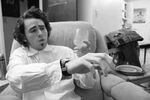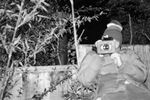Diego Buñodovar
Diego José Buñodovar de Paula Juan Nepomuceno Martel del los Remedios Cipriano de la Santîsima Trinidad, more commonly known as Diego Buñodovar, and at one point known only as Señor Buenasuerte, is and may always be one of the most renowned international filmmakers the world has ever seen, depending on whom you talk to. He appeared some time between 1901 and 1914. He was born in, and came of age in, the Las Hurdes region of Northern Spain and learned the art of cinema while traveling with Luis Buñuel. He is known primarily for his mastery and redefinition of many different filmic modes and genres as well as his tastefully grotesque and disgusting criticism of organized religion, xenophobia, and people who actually enjoy the taste of buttered popcorn jelly beans. Diego has won several awards, but none in the dominant international circuit.
Early Years: (Approx.)1910s-1935[edit]
Due in large part to the isolated and rural region in which Diego was born as well as his impeccable aging process, his birth date has been widely disputed in the film scholar sphere, but all agree he was born between 1901 and 1914 in Las Hurdes, Spain. Until the surrealist filmmaker Luis Buñuel arrived to make his famous parody of the newly formed documentary mode, Diego as well as the majority of hurdanos had never been exposed to cinema. He quickly became fascinated by the art form and kept accosting Buñuel until he gave in and reluctantly became his filmmaking mentor. To escape the less-than-desirable living conditions of the region as well as to develop his cinematography skills, Diego hitched a ride out of Las Hurdes with Buñuel's film crew to Paris, where he worked under Luis Buñuel dubbing films for Paramount Pictures.
After stealing his first camera from a French boutique, Buñodovar began making his first film, a documentary about the public's discomfort regarding his foreign upbringing, entitled ¿Por Qué Te Molesta?, released in 1935. The making of this film was arguably the springboard that triggered his future motif of harshly criticizing xenophobia. Bringing such a topic to the surface was very bold at the time, so people generally disliked the film upon its release. Not until 1963 was it recognized as one of the films that pioneered the documentary mode. The film's initial failure prompted Diego to move to Siberia, where he lived in seclusion for over 20 years.
1936-1960: Buñodovar's Wonder Years[edit]
While living in isolation in Siberia, Buñodovar discovered two things: his love for scatological, or "toilet" humor, and his bisexuality. It is largely speculated as to how he came to these discoveries, for he never talks about that 20-year period; the only thing he will say about it is, "Cocaine is a hell of a drug," and move right along as if the question had never been brought up. One certainty about this period is that he was constantly working on films of all types. Scholars believe this because at the end of his 20-year disappearance, he began distributing one highly produced film a month for 11 months. Critics were baffled by how fast he made his highly polished films, but his method became apparent. These films, which today tend to be clustered in a group that marks Buñodovar's "Siberian Period", cover a range of topics, bringing into question such ideas as gender roles and sexuality, organized religion, and social class structures. Out of 11 films, 8 were nominated for awards, but only one film won for best cinematography. One highly controversial film, whose Siberian title roughly translates to, I Can't Go To Church Today, I Have To Drink Beer, tells the story of eight upper-class men who make a pact to all have sex-change operations to disguise themselves as they attempt to take down every church of any denomination that they encounter. This film goes down in film history as being the first and only movie to so explicitly show one of the transsexual protagonists defecate on a bishop.
A Modern Buñodovar: 1960s- Present Day[edit]
For the past 40 years, Buñodovar has been constantly relocating, each time calling his new country his "home" country. He has stated that his goal before he dies is to make a film from every cultural perspective, while still criticizing the aspects he does not agree with. So far, most of his films have brought into question the notion of "who deserves to be seen onscreen," meaning that he tends to select marginalized demographics and focus on details that the world does not always see. To achieve his signature "raw" aesthetic, he often casts real people indigenous to the region as extras and supporting roles. Since about 1995, he has kept the motif of having strong female leads and literally impotent male characters because, he admits, "I like seeing old-fashioned people get offended at the modern world." As of the past 3 years Diego has been living in Finland where he is speculated to be working on a surrealist Argentinian-style melodrama. He was awarded best surrealist filmmaker of the 20th century in Libya in 1999.
Trivia[edit]
- Diego attributes his raw and disgusting style to being deeply influenced by Buñuel's shocking surrealism of the 1920s and 1930s.
- He has been at least slightly drunk since about 1939 and loves his signature drink, "El Buñòn."
- He had a lung transplant in 1955 so he would not have to give up his smoking habit.
- There are bits of humor in all of Buñodovar's films because, as he once told the press, "It is ingrained in my Spanish heritage to laugh at life."
- For reasons unknown, Diego detests buttered popcorn jelly beans and always places "Easter eggs" in his films referencing this quirk of his.


